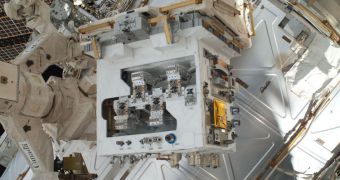According to officials at the American space agency, the NASA Robotic Refueling Mission (RRM) will change homes next month. The advanced experiment was developed in order to test whether refueling satellites and other spacecraft in space is possible and feasible.
The RRM was carried to low-Earth orbit (LEO) aboard the space shuttle Atlantis during its final mission, STS-135. After the demonstrator was installed outside the hull of the International Space Station (ISS), astronauts moved on to other tasks.
Now, NASA representatives announce that the experiment needs to be moved from its current location. Most likely, it will be placed atop the orbital lab's ExPRESS Logistics Carrier-4 (ELC-4) platform. The actual assessment activities on the demonstrator will begin only after the maneuver is complete.
The refueling station is a joint effort between NASA and the Canadian Space Agency (CSA). What the two space agencies are interested in is learning whether such an orbital capability will be able to serve satellites that were not designed with servicing in mind.
This is very important due to the high number of old spacecraft in Earth's orbit. These include defense satellites, all the components of the Global Positioning System (GPS), several telescopes and so on.
Boosting their individual life spans could reduce governmental expenses by billions of dollars. Still, before this can be done, scientists need to test the technology, and ensure that a robotic refuel&repair station will not do more harm than good.
Even US President Barack Obama took note of the potential for innovation the RRM carries when it comes to the commercial satellite industry. He expanded on this issue during a phone call he made to the STS-135 crew on July 15.
“It’s a good reminder of how NASA technology and research often times has huge spillover effects into the commercial sector, and makes it all that much more important in terms of peoples’ day to day lives,” the President told the astronauts.
“Robotic refueling and satellite servicing could extend the lifetimes of satellites, offering significant savings in delayed replacement costs,” explains NASA official Frank Cepollina.
He holds an appointment as associate director of the Satellite Servicing Capabilities Office (SSCO), which is based at the NASA Goddard Space Flight Center (GSFC), in Greenbelt, Maryland.
“Such servicing has the potential to allow human and robotic explorers to reach distant destinations more efficiently and effectively,” he concludes.

 14 DAY TRIAL //
14 DAY TRIAL //